Mastering Midjourney Prompts for Stunning Images17 Jun 2023 / 40 minutes to read Elena Daehnhardt |
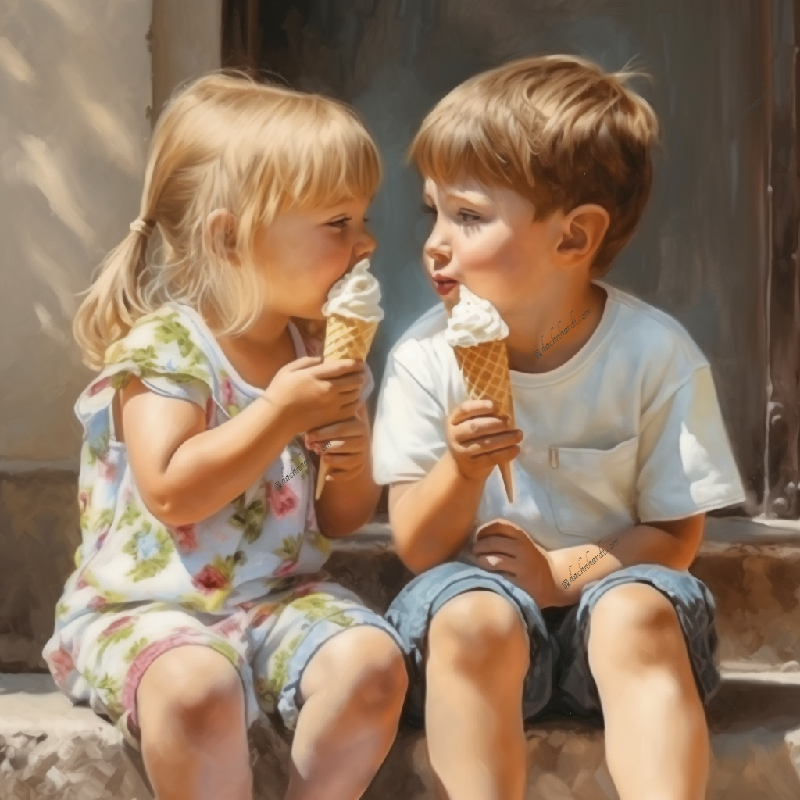
|
Introduction
In this post, I write about creating images with AI tools, shortly introducing the most prominent to date and going deeper into one of my favourite tools. I use Midjourney to create stunning and futuristic designs for an ice cream shop. Why is that? It is roasting in the Netherlands these days, and I wanted to draw something cool and sweet. Let’s go!
AI-powered art tools
I like playing with Jasper.AI and Midjouney. However, so many AI-powered platforms and tools can generate art! They range from simple image filters to more complex generative models. Some famous examples of AI-powered art generation platforms include:
- Deep Dream is a software that uses a neural network to find and enhance image patterns. If you like coding, I suggest checking the TensorFlow tutorial about DeepDream.
- Prisma uses machine learning algorithms to transform photos into artwork inspired by different artistic styles.
- ArtBreeder is an online platform that allows users to mix and match different visual elements to create unique pieces of art using deep learning models.
- NeuralStyle is a tool that uses neural networks to apply the style of one image to another, creating a hybrid image that combines both styles.
- Runway ML is a platform that offers a variety of pre-trained models for generating art, such as style transfer, image synthesis, and object detection.
- Jasper.ai is an AI-powered art generation platform that uses deep learning algorithms to create unique artworks based on user inputs. Users can choose styles, colours, and visual elements to generate personalised artwork.
- DALL-E2 is a language-based image generation system created by OpenAI. It uses a transformer-based neural network to generate images from textual descriptions, allowing users to create custom images based on written prompts.
- craiyon is a free web app that generates images from text.
- Midjourney is an AI-art generation tool that creates fantastic images based on text prompts or with user image inputs. Midjourney requires the Discord app, which is quite easy to install.
These applications rely on machine learning and AI and can be used to create art in new and innovative ways, expanding the boundaries of what is possible in visual expression.
How do these AI art generators work?
AI art generators use machine learning algorithms, such as deep neural networks, to learn patterns and styles from existing images and then use that knowledge to create new images. The process typically involves feeding a large dataset of pictures into the algorithm, which then analyses and identifies common patterns and styles. Once trained, the algorithm can generate new images based on the learned patterns and styles by modifying existing images or creating entirely new ones.
For example, the GAN (Generative Adversarial Network) algorithm, used by DALL-E and other AI art generators, consists of two neural networks: a generator and a discriminator. The generator creates new images, while the discriminator evaluates how closely the generated images resemble real ones. The two networks are trained together, with the generator attempting to create images that can fool the discriminator into thinking they are real. As the networks improve, the generated images become increasingly sophisticated and can exhibit unique styles and characteristics.
Similarly, Stable Diverse Image-to-Image Translation (StableDiffusion) uses a diffusion-based generative model, which gradually alters an image over multiple steps to create a final output image. The model learns how to make these gradual changes from a dataset of images and can create new, unique images by applying the same process to new input images.
Overall, AI art generators use complex algorithms and deep learning techniques to learn and mimic the patterns and styles of existing images, allowing them to create new and unique art pieces that can be highly sophisticated and visually appealing.
Next, we will practice creating AI designs with Midjounrey and save some useful prompts and parameters for future reference.
Midjourney bot
Midjourney is an incredible way to make art with the help of artificial intelligence. First, you’ll need to download Discord and set it up on your computer. Once you’re comfortable with that, you can start using Midjourney by talking to its bot. This bot can help you create all sorts of unique images, and it’s a great way to explore the world of AI art.
Once you’ve signed up, you can join one of the “Newbies” channels on their server and create unique designs with just a few simple commands. Using the powerful “/imagine” command, the Midjourney bot will generate four variations of your image, each one more stunning than the last.
But that’s not all – with the Pro plan, you’ll unlock even more amazing features, like Stealth Mode support. With this powerful tool, you can create and explore without worrying about your designs being seen by others.
Use cases
The Midjourney bot can create stunning images. Some of the examples of use cases:
- Design Unique Logos: Use the Midjourney bot to create one-of-a-kind logos for your business or brand. With the ability to generate multiple variations of an image, you’re sure to find a design that’s perfect for you.
- Generate Avatars for use on social media.
- Generate Images of people for use in marketing designs or for websites.
- Create poster-like designs for your advertisements.
- Create comic strips.
- Create Custom Greeting Cards: Want to send a unique and personalised greeting to a friend or loved one? With Midjourney, you can create custom greeting cards that feature stunning AI-generated art.
- Generate Art for Your Music: Whether you’re a musician or a music producer, you can use Midjourney to create stunning cover art for your tracks or albums.
- Make Eye-Catching Infographics: Need to present data or information visually appealingly? Use the Midjourney bot to generate unique and eye-catching infographics that will impress.
- Create Unique Desktop Wallpapers: Use Midjourney to generate beautiful and unique wallpapers for your desktop or mobile device. With the ability to create multiple variations of an image, you can switch things up whenever you want!
- Generate multiple variations of the image, and create unique GIFs with the images generated.
Besides creating beautiful images, you can mitigate a creative block using AI-art generators like Midjourney.
Pitfalls and Limitations
While AI art generators like Midjourney can be handy and exciting tools, there are a few potential pitfalls and limitations to keep in mind. Here are some to consider:
- Lack of Control: While AI art generators can produce stunning and unique images, you need full control over the creative process. The final output may not always match your expectations, which can be frustrating.
- Unoriginality (or lack of creativity): Since many people have access to the same AI art generators, there’s a risk that your designs could end up looking similar to others.
- Dependence on Technology: Relying too heavily on AI art generators can lead to losing traditional artistic skills and techniques.
- Copyright and Intellectual Property Issues: It’s essential to be aware of copyright and intellectual property issues when using AI-generated art, as the images you create may not be entirely your own.
- Dependence on Data: AI-art generators require large amounts of data to work effectively. If the data sets used to train the AI are limited or biased, it can impact the quality of the generated images.
- Ethical Considerations: There are also ethical considerations to keep in mind, such as using AI-generated images in advertising or other commercial contexts without proper consent or attribution.
- Technical Barriers: Using AI art generators requires technical knowledge and skills, which can be a barrier for those unfamiliar with programming or machine learning.
Designs for an Ice-cream cafe
I don’t like to be very theoretical, and prefer “learning by doing”. Let’s practice with Midjourney art-generation while creating stunning designs for an ice-cream cafe.
Setup
You will have to prepare before you go into the depths of AI-generated art. The setup process is straightforward:
- You have to install Discord to use the Midjourney bot
- It is essential to decide which version you want to use.
- You must invent your prompts and learn useful keywords to create designs you like.
Do not worry; we will do it gently.
First of all, we will have to install the Discord app and read Midjourney’s Quick Start documentation about using their bot. You will join the Midjouney server and enter any #General or #Newbie channel.
Secondly, there are five versions of Midjourney, starting from V1, released in March 2022, and the latest V5 released a year later. All versions provide different features and, thus, different styles of the created images. V5, the current version, offers more detailed and realistic images, enhanced styling features, and wider aspect ratios. We will use V5 in this tutorial.
To use version 5, you will have to add the following to your prompts:
--v 5
Please notice that –v is short for -version, and you can specify any version number this way.
If you prefer using the same version across several of your creations, you can simply define your version while typing in “/settings”.

Midjouney /settings command
And finally, we will type in “/imagine” followed by your prompt describing your desired image and optionally include keywords we further try out. Alternatively, you select the “/imagine” command from the pop-up list, which contains more useful commands such as “/settings”.
Midjourney prompts
You can invent your prompts, or you can try out these together with me:
Creating a logo
I need help selecting colours, and creating a simple logotype is challenging—no wonder I am not a graphic designer. Can we exploit the Midjourney bot for this artistic task of creating logos? Let’s try.
A futuristic logo for an Ice-cream cafe neon color pallete
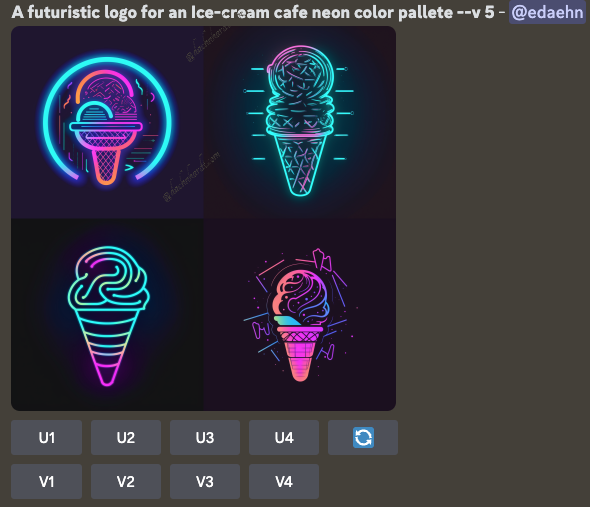
You might realise that I had defined the neon colour and had a typo in the word “palette”, which was worked just fine. However, checking the spelling to get the needed results is still good.
Below the image grid of four image variants, you see a set of buttons. For each image variant, you can get an unscaled image by pressing “U” buttons, and get more variations with “V”. Next, I pressed “V3” to get my logo variations for the 3rd image.
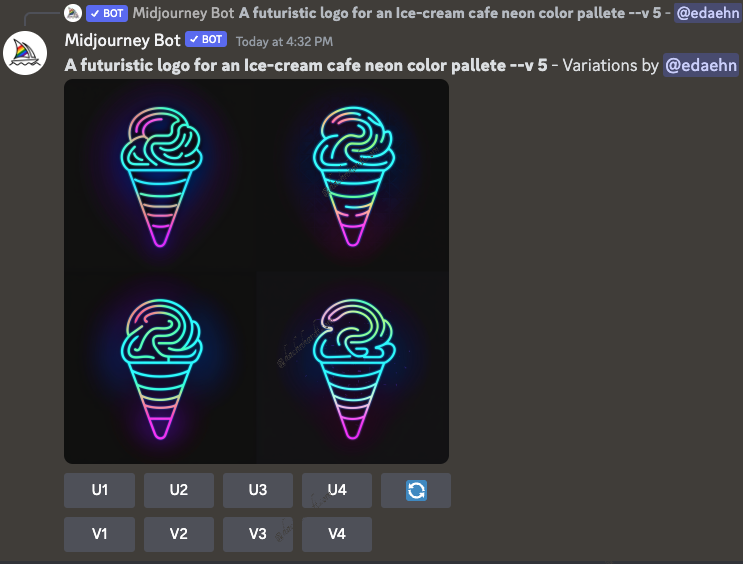
Advertisement ads and billboards
We don’t have to hire expensive designers. We can try AI bots for creating ads and billboards. Alternatively, we can get some starter ideas that can be used for creating compelling billboards or advertisement banners.
ad design for an Italian ice-cream cafe
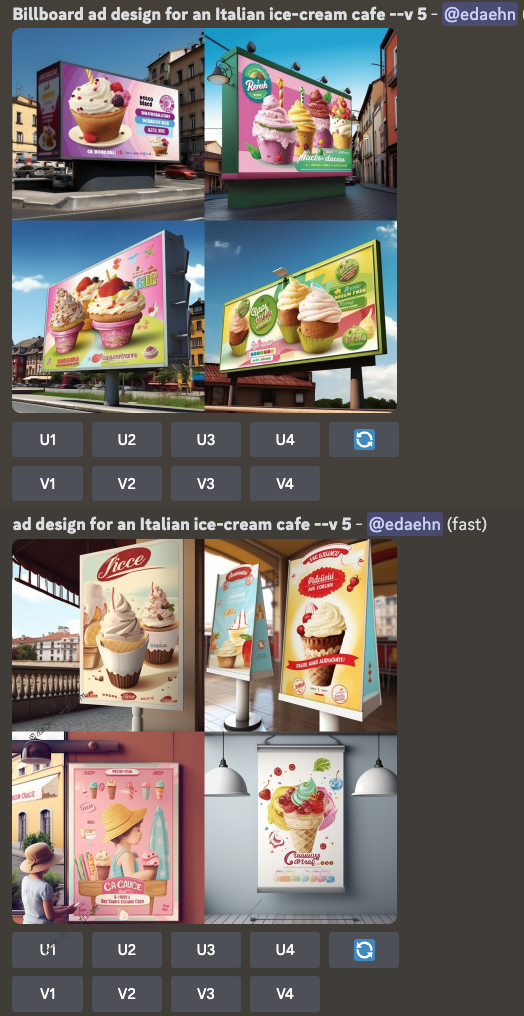
Photorealistic images
Midjourney can create images that look like photographs. For any business, Midjourney can create lovely photo-like designs that fit their purpose in advertising, marketing or simply for decoration and joy.
Children eating ice-cream cones, photorealistic
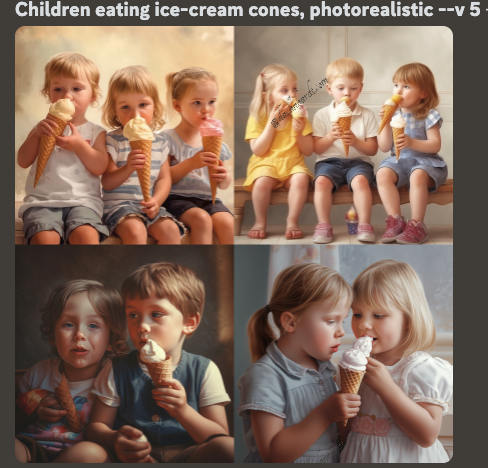
Next, I will write helpful keywords that you can try out for your designs.
Concept art
We want to create our cafe menu card and use concept art for the front-cover.
happy marshmallows jump on a huge ice-cream cone, adventure, intricate detail, concept art, HD
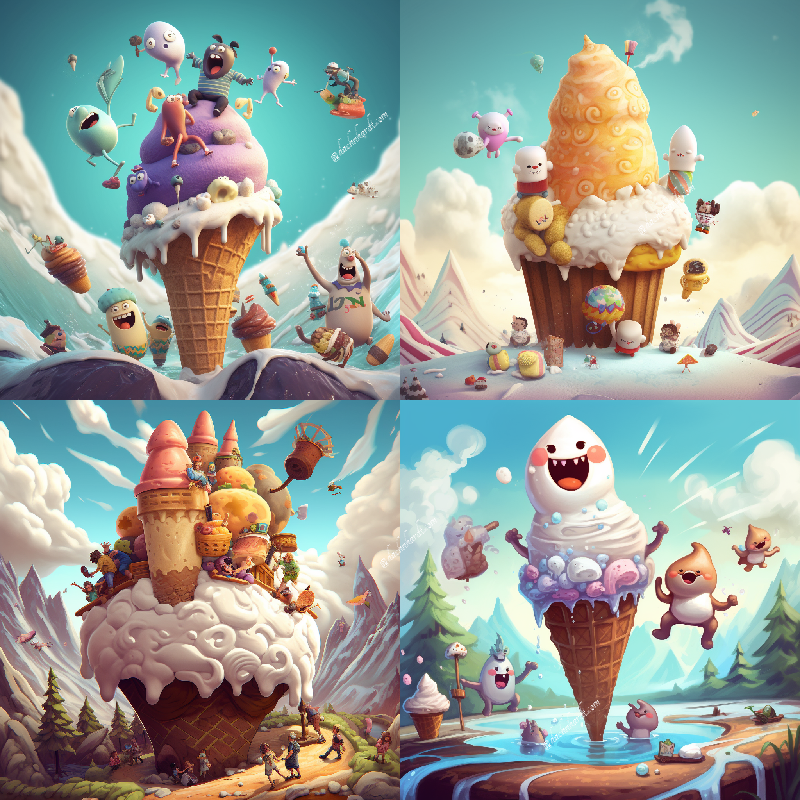
Comic strip
We want to create a comic strip to share on social media to advertise our ice cream cafe.
The image below is the second variation. What do you think about the image in the bottom right corner? I find it quite scary, and there is no snowman too.
Please notice that I have defined –v 5.1 for the best results.
Snow falls, and children make a snowman. A polar bear eats an ice cream cone, which is covered with marshmallows, 4 panels, a vintage children’s comic book strip, 8k HD, --v 5.1
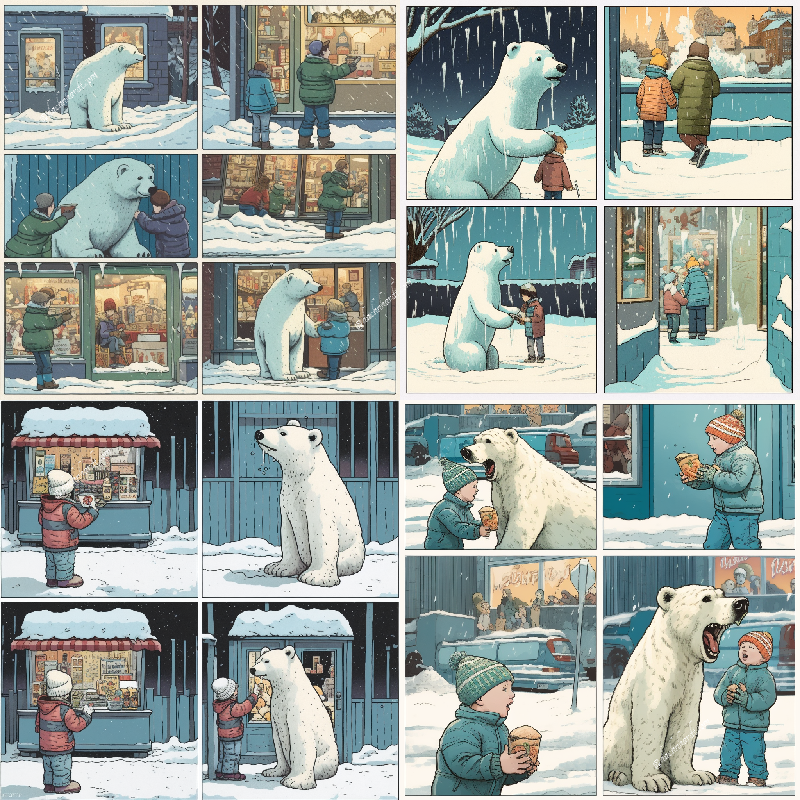
Useful keywords
I always like to keep a log of useful keywords, and I share them herein. I have intentionally included keywords not used in this post. You can try out them as your “homework”. Ha-ha, I hope that you are a responsible student.
I have included keywords which primarily work with version 5. For instance, -tile for creating tiled repetitive patterns, introduced in version, dropped in versions 2 and 3, dropped out of the version4, and reborn in version 5 :)
Please notice that often I show one of the best images or their variations generated. I have started to save space since this blog grows. Interestingly, I realised that it is often not helpful to repeat variations. Usually, the bot shows the best variation at first.
Style
Use the word “style” with your preferred style, for instance, a realistic image, photo, 2D illustration style, psychedelic style, Japanese anime style, cyberpunk style, grunge style, or vampire design. Alternatively, add an artist’s style, for instance, Dali’s style.

Midjouney: Children eating ice-cream cones, japanese anime style
Stylize, level of abstraction
Takes a number from 0 to 1000 to increase or decrease the level of abstraction in the subject

Midjouney stylize from 0 to 1000: Children eating ice-cream cones, japanese anime style
Lighting
Lighting is a fundamental aspect of art and can set up the mood and eye-catching results. Try out these Lighting descriptions that can lead to fantastic and more artistic results:
- Global illumination is a technique used to create a more natural and visually appealing rendering of a three-dimensional environment.
- Natural light that can produce soft, diffused lighting conditions, particularly during the golden hours, which are the periods shortly after sunrise and before sunset. These times of the day offer warm, flattering light that enhances the textures, colours, and depth in photographs.
- Uplight refers to the illumination directed upward from a light source. This technique focuses on lighting the ceiling, walls, or objects above the light fixture. Instead of primarily illuminating the space below, uplighting creates a vertical emphasis and can enhance the overall ambience of a room or outdoor area.
- Ambient Lighting can contribute to the overall ambient lighting in a space by bouncing light off ceilings and walls, creating a soft, diffused glow. This can help distribute light evenly throughout the room and reduce harsh shadows.
- Cinematic lighting refers to the deliberate and stylized use of lighting techniques in photography or filmmaking to create a specific mood, atmosphere, or narrative effect.
- Softbox lighting is a technique that involves using a light source with a diffusing material, typically a softbox, to create a soft, even, and flattering light with minimal harsh shadows.
- Long exposure lighting is a technique where the camera’s shutter is left open for an extended period, allowing more light to be captured, often resulting in blurred or streaking light effects.
- Fairy lighting refers to decorative lighting that typically consists of small, delicate, and often twinkling lights used to create a magical or whimsical ambience, often associated with outdoor or festive settings.
- Studio lighting refers to using artificial lighting equipment, such as strobes or continuous lights, in a controlled indoor setting to illuminate subjects for photography or video production.
- Ray tracing is a computer graphics technique that simulates the path of light rays in a virtual environment to create highly realistic lighting and reflections in rendered images.
- Volumetric lighting, also known as a god or crepuscular rays, refers to the effect of light scattering or shining through a medium, such as fog, smoke, or dust, creating visible beams or shafts of light.
- Rim light is a technique where a light source is positioned behind the subject, often from the side or back, creating a highlight along the subject’s outline or edges, separating it from the background and adding depth to the image.
I this image prompt I use rim light and the most recent version 5.1.
a beautiful 5 year old happy girl with golden curls eating an ice cream cone, photorealistic, rim light --v 5.1

Please note that the Midjourney version 5.2 was just released this week on the 22nd of June, 2023. It has better image quality, enhanced image variations, and a zoom-out feature that appears after upscaling an image (see image below). It is possible to zoom out, and more exciting features I will write about soon.
The image below shows more varied output of the image generation in the newest version 5.2 (in the time of updating this post). You will see “Zoom” buttons after upcsaling your chosen image.
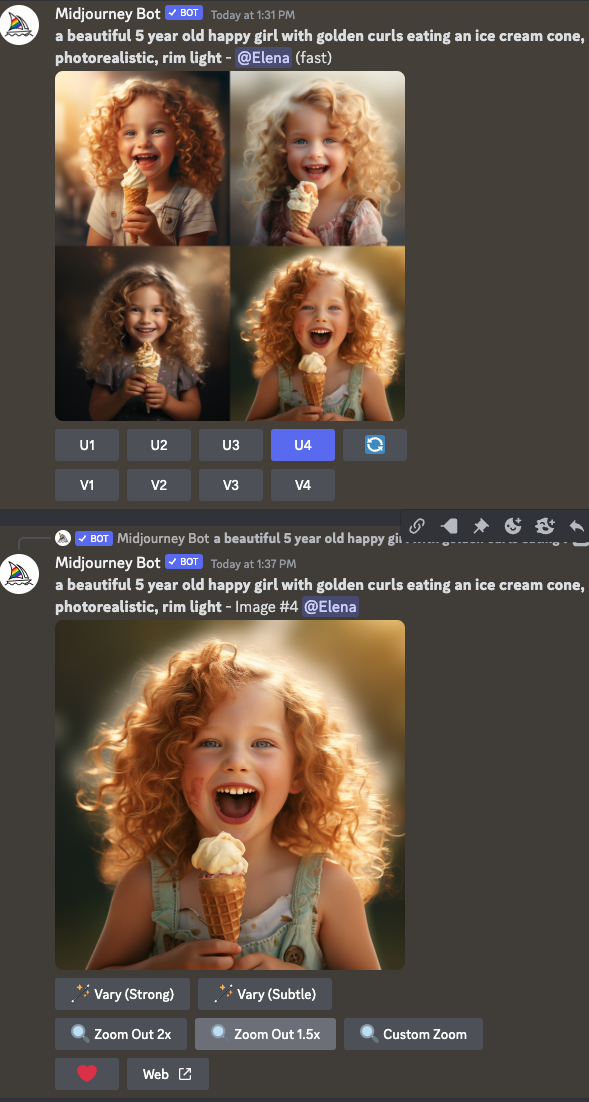
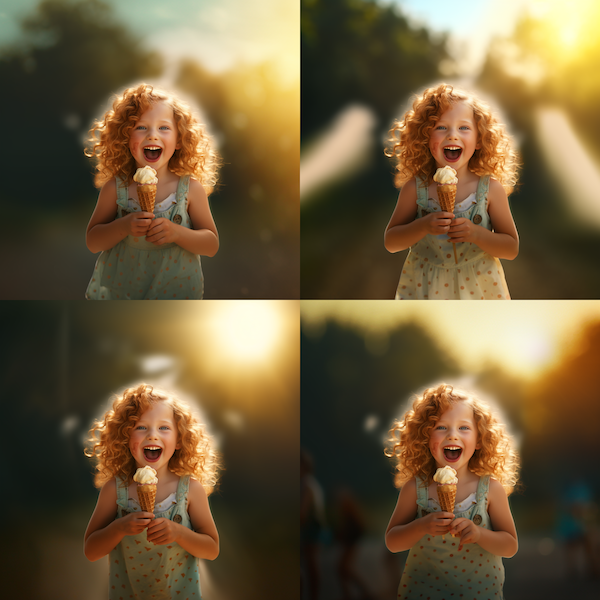
Resolution
I like creating photorealistic and highly detailed images:
Children eating ice-cream cones, photorealistic, ultra detailed --v 5
It’s funny, while creating these beautiful images, a new Midjourny button appeared! I clicked “Remaster”, and got new images!
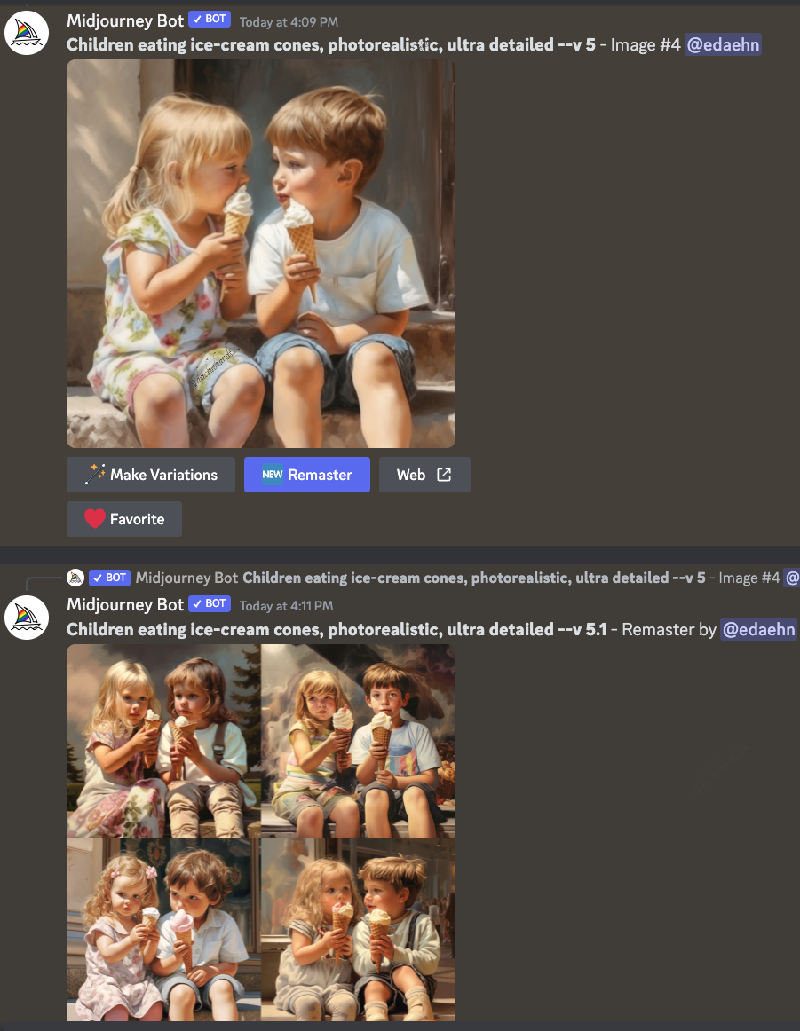
Midjouney: Children eating ice-cream cones, photorealistic
You can try these resolutions: 8K, 4K, photorealistic, ultra photoreal, ultra-detailed, intricate details, HD.
a cotton candy cupcake with strawberries and ice cream, photorealistic HD --v 5.1

In version 5.1 it looks idealistic. It reminds me of the menu cards with too beautiful food images :)
However, we can make it look authentic by adding a top-down view, environment and lighting details. Additionally, we can select a preferred camera, as I will show further for creating a photo with pancakes. I hope that you are well-fed.
Chaos
High –chaos values (the maximum is 100) will produce more unusual and unexpected results and compositions. Lower –chaos values have more reliable, repeatable results. The –c 80 will produce very varied image results.

Midjouney chaos: An ice-cream cone --c 80
Aspect ratio
The default output in Midjourny images is a square image (1:1 aspect ratio) You define your own such as:
--ar 4:3
Passing an image URL
Combining image (using its URL) and text inputs is possible. For instance, I took my photo and added am ice cream.
To get better results, I have added “photorealistic, ultra detailed” with the middle level of abstraction –s 500.
https://s.mj.run/hoACFfamsNg ice cream, photorealistic, ultra detailed, --s 500
I had to do variations since some of the first results presented a massive ice cone which looked a bit strange for my taste :) The upscale result is below. I like the caramel glazing.
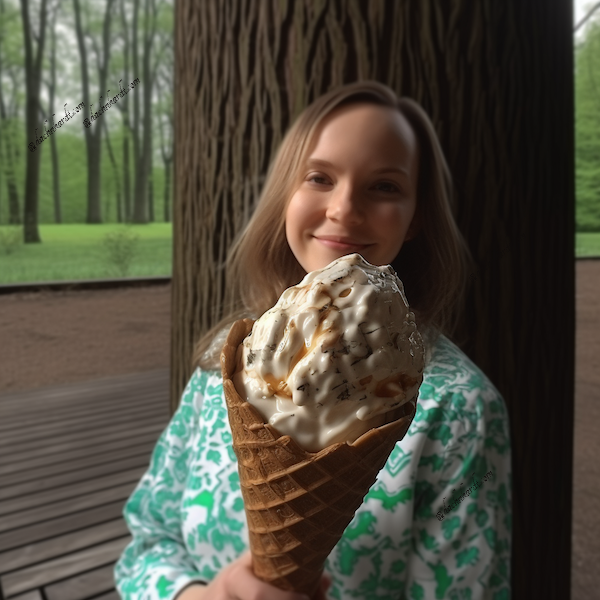
If you want your output to look more like your prompt image, apply a higher or lower weight to the image with –iw
image_URL text prompt --iw 0.8
Filter words
Use the –no keyword to discard any unwanted subjects in your generated images. Unfortunately, I could not get ice cream images without waffles, which is critical for persons on GF diet!
Ice cream high detail, --no waffle

Art medium
Defining your art medium with words ink, paint, drawing, pencil, marble or mosaic is easy.
Ice cream in marble medium

My favourite chatGPT jokes about that marble cones (Create me 10 jokes on: “Don’t break your teeth on those marble cones.”):
- I tried eating a marble cone once, but it didn’t go well. It was a real “jaw-breaking” experience!
- I’m always cautious when eating marble cones. I don’t want to end up with a “rock-hard” smile!
- I went to an ice cream parlor and they offered me a marble cone. I declined, saying I wanted something with a little less “bite”!
Camera settings
Midjourney understands prompts that include camera descriptions, film stock, lenses and focal points to convey the photographer’s artistic vision and enhance the emotional impact of an image. Try following camera settings for creating digital artwork that fits your purpose:
- Specify desired cameras such as Nikon D850, Sony Alpha a7R IV, Panasonic Lumix S1R to achieve desired image quality.
- Ilford film stock for creating classic and artistic black-and-white photography
- High-key photography is a style that predominantly uses bright, evenly lit scenes with minimal shadows and a light colour palette. The goal is to create a clean, airy, and upbeat atmosphere. High-key lighting typically involves using multiple light sources, soft diffused lighting, and white or light-coloured backgrounds. This technique is often employed in fashion photography, product photography, and portraits to convey a sense of positivity, energy, and a clean aesthetic.
- Low-key photography embraces darker tones, deep shadows, and a limited range of lighting. It often contrasts light and dark areas, creating a moody, dramatic, and sometimes mysterious ambience. Low key lighting is achieved by using a single key light or a small number of light sources, often positioned at angles to create intense shadows and emphasize specific areas of the subject. This technique is commonly used in genres such as film noir, fine art photography, and portraits to evoke a sense of tension, mystery, and sophistication.
- High-contrast images often have bold, dramatic lighting with strong shadows and highlights. This can create a visually impactful and dynamic effect, drawing attention to specific areas and adding depth and intensity to the photograph.
- Low-contrast images often have a more muted and subtle appearance, with smoother transitions between tones. This can create a gentle and understated mood, conveying a sense of tranquillity or a dreamy atmosphere.
- f/1.8 refers to the maximum aperture of a camera lens that helps isolate the subject and create a pleasing separation between the foreground and background.
- 16-35mm lens, a wide-angle zoom lens, allows you to capture a broad scene in a single frame. This makes it suitable for landscape photography, architecture, and interior shots where you want to encompass a large area.
To create a tasty photo of pancakes, I have chosen Nikon D850, global illumination lighting and the desired aspect ratio with version 5.1.
food photograph of pancakes with ice cream and strawberries on a wooden dark table, Nikon D850, global illumination --ar 16:9 --v 5.1
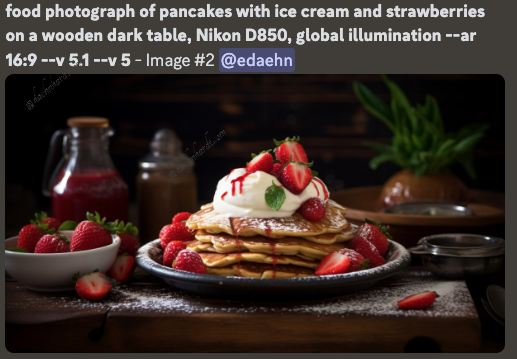
Portraits and natural features
Experiment with “close-up” views and use “clear facial features” for creating human portraits. You can achieve natural-looking skin with “hyper-realistic skin” added to your prompt.
I have also used version 5.1 to produce this image since the –style parameter is unavailable in version 5. Midjourney version 5.1 delivers photorealistic images with the helpful raw style.
close up portrait photo of two beautiful 20 year old tween girls with ice cream, hyper realistic skin, global illumination, --style raw --v 5.1

Does Midjourey know what tweens are? Notice that girls on the grid are very alike in their facial features.
Consider increasing your image quality with “–q 2” in version 5. In Midjourney 5.1, this quality level is the default.
Mix different styles
To achieve fantastic results, use style fusion by combining different styles. Here are five options of style fusion that mix different art styles in digital art:
- Cubism Surrealism Fusion combines elements of Cubism, known for its fragmented and abstract representations of objects, with Surrealism, which focuses on dreamlike and irrational imagery. It can result in artworks that feature disjointed perspectives, distorted forms, and unexpected combinations of objects and symbols.
- Pop Art Street Art Fusion merges the bold, vibrant, and consumer culture-inspired style of Pop Art with the expressive and urban aesthetics of Street Art. It can use bright colours, iconic imagery, and street-inspired techniques such as stencils and graffiti elements.
- Impressionism Digital Collage Fusion combines the loose brushwork and emphasis on the light and colour of Impressionism with the modern digital collage technique. It can involve blending fragmented images, creating layers of textures and patterns, and incorporating Impressionist-inspired brushstrokes and colour palettes.
- Renaissance Cyberpunk Fusion juxtaposes the classical aesthetics of the Renaissance, characterized by realistic representation and harmony, with the futuristic and dystopian themes of Cyberpunk. It can result in artworks featuring Renaissance-inspired figures, architecture, or clothing in a high-tech, neon-lit, futuristic setting.
- Abstract Expressionism Pop Surrealism Fusion combines the spontaneous and expressive style of Abstract Expressionism with the whimsical and imaginative elements of Pop Surrealism. It can involve bold brushwork, drips, and gestural marks combined with surreal or fantastical imagery, creating a visually striking and thought-provoking combination.
These are just a few examples of style fusion in digital art, and the possibilities are virtually limitless. Artists often experiment with different combinations and interpretations to create unique and engaging artworks that push the boundaries of artistic expression.
Dimensions
Define your image dimensions 2d-5d, or even multiverse!
Colour palettes
Colour palettes play a significant role in influencing human perception in digital art. Here’s a description of the effects commonly associated with different colour palettes:
- Warm colour palettes, including red, orange, and yellow hues, evoke feelings of warmth, energy, and excitement. They can create a sense of passion, intensity, and vibrancy in digital art, often used to convey happiness, enthusiasm, and cosiness.
- Cool colour palettes, such as blues, greens, and purples, have a calming and soothing effect on human perception. They can evoke a sense of tranquillity, serenity, and peacefulness. Cool colours are often used to represent emotions like calmness, stability, and introspection.
- A rainbow colour palette comprises a full spectrum of colours, creating a rich and dynamic visual experience. It can evoke feelings of joy, playfulness, and diversity. Rainbow palettes are often used to express positivity, celebration, and inclusiveness.
- Tonal colours refer to a restricted range of closely related hues within a colour family. Tonal colour palettes can create a harmonious and unified aesthetic in digital art. They provide a sense of cohesion and balance, often used to evoke a subtle and sophisticated atmosphere.
- Saturated colours are intense and vibrant, with high chromatic intensity. They can evoke strong emotions, grab attention, and create a sense of dynamism and excitement in digital art. Saturated colour palettes are commonly used to make elements pop and convey energy and boldness.
- Neon colours are incredibly bright and intense, often associated with fluorescent or electric hues. They can create a striking and attention-grabbing effect, conveying a sense of modernity, technology, and vibrancy. Neon colour palettes are frequently used in digital art to create a futuristic or visually stimulating atmosphere.
- Complementary colours are pairs of colours that are opposite each other on the colour wheel, such as blue and orange or red and green. Complementary colour palettes create a strong contrast and visual impact when used together. Depending on the specific colours and their arrangement, they can develop a sense of tension, excitement, or balance in digital art.
- Light and dark, often called value contrast, affect the perception of depth, mood, and focus in digital art. Light colours tend to feel uplifting and open and emphasize positive aspects, while dark colours can convey mystery, depth, and introspection. The interplay between light and dark creates visual interest and guides the viewer’s attention.
Colour palettes profoundly impact human perception, emotions, and the overall atmosphere of digital art. Artists strategically select and combine colours to evoke specific responses, convey meaning, and create unique visual experiences.
Emoji
It is fantastic that you can use emoji in prompts. Midjourney does a really great job
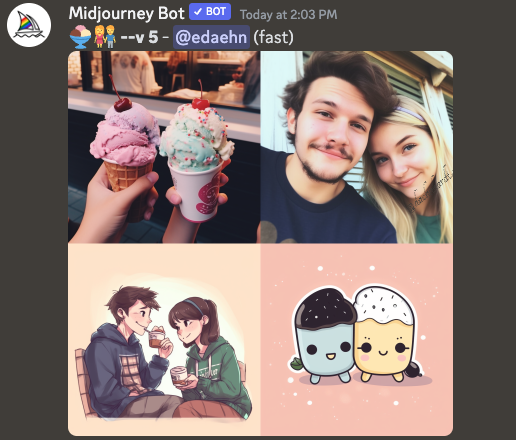
Midjouney 🍨👫
Material
Define the material of your creation using keywords such as wood, glass, crystal, metal, ice, snow, cloth, plants.
Reflection
Experiment with the Reflection: ray tracing reflection, lumen reflection.
Tiling
To create repetitive patterns, use tiling:
Colorful ice-cream cones, –tile
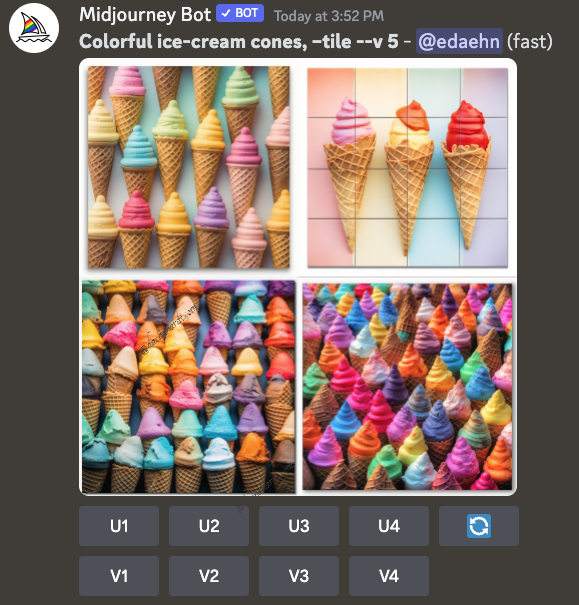
Midjouney -tile version 5 for ice-cream cones
Seed parameter
Midjourney generates images randomly so the same prompt can produce different results. Sometimes we want to make different alterations while preserving the same image. It is also quite useful to have reproducible results, for which the seed parameter is handy.
With the “–-s [seed_number]” parameter, we can control the algorithm’s randomness and get almost the same image that was generated the first time. I use seed number 75.
A laughing, happy child with a tasty ice cream cone, soft natural lighting --s 75
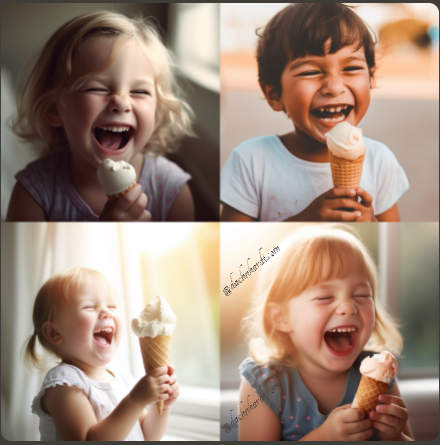
We can rerun the prompt with the seed. And, result is very similar.
Weights
We can emphasise chosen prompt elements or make them less prominent. For this, we use q positive or negative ratio number after :: for a defined (inside brackets) part of prompt or element.
For instance, we can give the highest importance to the words “tasty ice cream cone” to ensure it appears in our images.
A laughing::1, happy child::1 with a [tasty ice cream cone]::3 surrounded by flying white pigeons::2, photorealistic, soft natural lighting --s 75 --v 5.1
I have also used version 5.1 since it gives a better image quality.
In the same way, we can make things less prominent, and we can use negative weights or remove them. Let’s remove the ice cream cone.
A laughing::1, happy child::1 with a [tasty ice cream cone]::-1 surrounded by flying white pigeons::2, photorealistic, soft natural lighting --s 75 --v 5.1
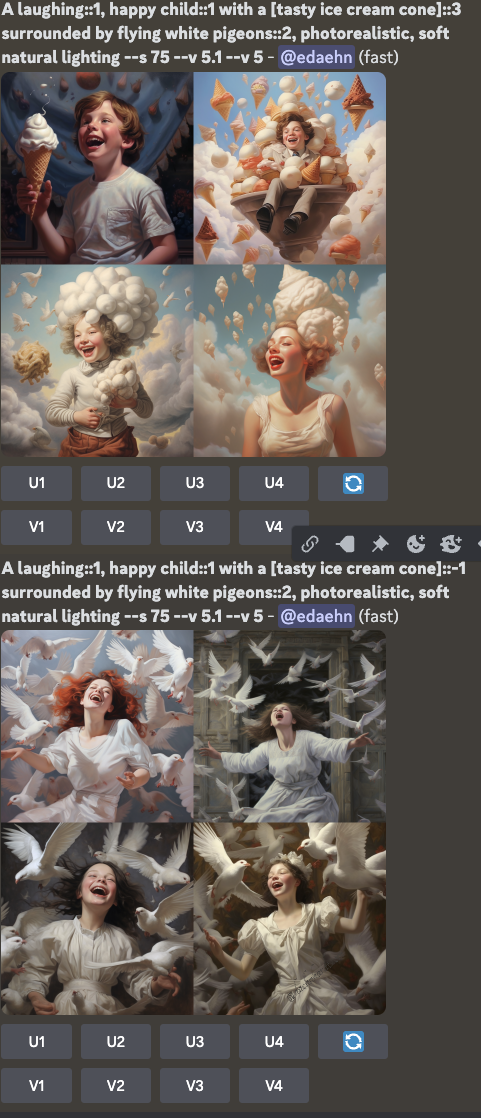
See the difference? The upper image features an abundance of ice cones, while the image below - pigeons.
Since the child weighs one, both images also show adult characters. Let’s fix it. We give a higher priority to “child”.
A laughing::1, happy child::3 with a [tasty ice cream cone]::-1 surrounded by flying white pigeons::2, photorealistic, soft natural lighting --s 75 --v 5.1
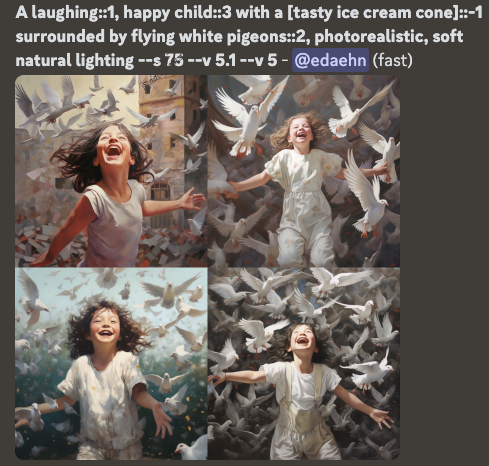
We have a happy child in each image and white pigeons, but no tasty ice creams.
Please notice that the sum of your weights should be positive. Otherwise, you will get the “Invalid prompt” message.
Prompts Builders
Should you be interested in creating the detailed design prompts, you can check up these links:
- Midjourney Prompt Builder
- REALISTIC PORTRAITS MIDJOURNEY PROMPTS
- IMI PROMPT: Midjourney Prompt Builder v5
For the whole list of Midjourney parameters, refer to the Midjourney docs.
Tips for Success
Overall, I have experimented with Midjourney while creating different complexity of prompts, and I have several points to take away. To create amazing images, we can follow these tips:
- Start with the most straightforward prompt. The longer prompt does not mean a better result.
- Place the most essential ideas at the beginning of your prompt.
- Read docs and learn how to use lighting and lens.
- Start with your images and refine the output in iterations.
- Learn how to set priority and remove elements with ::
- Experiment, refine, and try again.
- Have fun!
Conclusion
In this, as usual, detailed post, I have described helpful Midjourney prompts and keywords to take away. Besides, we have created beautiful designs of an Ice-cream shop with futuristic style and stunning colours. I plan to develop highly-detailed images in Midjourney in one of my future posts.
Stay tuned with my free-subscription on latest posts!
Thanks for reading, and have a lot of fun while playing with Midjourney.
Please let me know what interests you while creating your AI designs and whether I should add anything to this topic.
Did you like this post? Please let me know if you have any comments or suggestions.
AI-generated art and music/sound posts that might be interesting for youDisclaimer: I have used chatGPT while preparing this post. This is why I have listed the chatGPT in my references section. However, most of the text is rewritten by me, as a human, and spell-checked with Grammarly. All prompts were tested in Midjourney.
References
- Quick Start documentation
- Midjourney
- DeepDream
- Runway ML
- Deep Dream
- NeuralStyle
- Midjouney server
- Discord
- New Chat (chatGPT by OpenAI)
- Prisma
- Jasper.ai
- DALL-E2
- craiyon
- ArtBreeder
- Midjourney Prompt Builder
- REALISTIC PORTRAITS MIDJOURNEY PROMPTS
- IMI PROMPT: Midjourney Prompt Builder v5
- Midjourney docs: Parameter List

|
About Elena Elena, a PhD in Computer Science, simplifies AI concepts and helps you use machine learning.
|